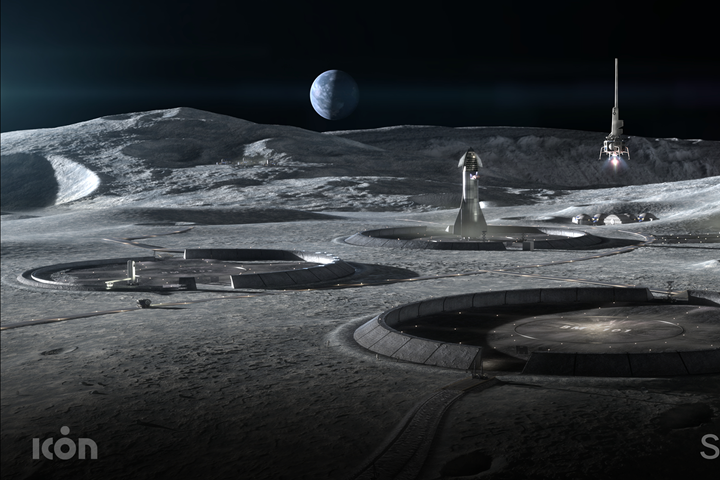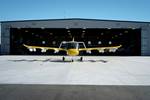NASA looks to advance 3D printing construction systems for the Moon and Mars
Off-world construction is taken to a new level with NASA’s MMPACT project, which will test lunar soil simulant with various processing and printing technologies to determine 3D printing feasibility in space.

ICON illustration of a conceptual lunar base with 3D-printed infrastructure, including landing pads and habitats. Photo Credit: ICON/SEArch+
On Dec. 1 it was reported that NASA is working with ICON (Austin, Texas, U.S.), a construction technologies company, on early research and development of a space-based, large-scale additive construction system that could support future exploration of the Moon and Mars. The company has already 3D printed communities of homes and structures on Earth and participated in NASA’s 3D Printed Habitat Challenge, demonstrating a construction method and technologies that may be adaptable for applications beyond Earth.
According to NASA, the process of building landing pads, habitats and roads on the Moon will likely look different than a common construction site on Earth. With this in mind, as part of the Artemis program, NASA has a concept for the core surface elements needed to establish a sustained presence on the Moon, which emphasizes mobility to allow astronauts to explore more and conduct more science, an agency that requires investment in advanced manufacturing.
“To be successful in our future missions, we have to invest in new, cutting-edge technologies today,” says Niki Werkheiser, NASA’s Game Changing Development program executive. The program is part of the agency’s Space Technology Mission Directorate. “Near-term research and development will help ensure we can expand building capabilities on other worlds when the time comes.”
Another U.S. government agency expressed interest in the technology and its applications here on Earth as well. The U.S. Air Force awarded ICON a dual-use Small Business Innovation Research (SBIR) contract to expand 3D printing of livable and workable structures. Part of the contract, which NASA contributed funding to, will explore commonalities between Earth-based and off-Earth applications. ICON will also invest in the effort.

Illustration of a Mars habitat concept developed by the Colorado School of Mines and ICON for NASA's 3D-Printed Habitat Challenge. Photo Credit: Logan Architecture
“Joining forces and cost-sharing among multiple government agencies allows us to accelerate the development timeline and bring the core capabilities that we have a common interest in to fruition sooner,” says Werkheiser. “Together, we will help mature technologies that will have benefits for humanity — on Earth and in space.”
ICON will work with NASA’s Marshall Space Flight Center in Huntsville, Alabama, under the Moon to Mars Planetary Autonomous Construction Technologies (MMPACT) project to test lunar soil simulant with various processing and printing technologies. NASA is partnering with industry, government, and academic institutions under the MMPACT project.
“We want to increase the technology readiness level and test systems to prove it would be feasible to develop a large-scale 3D printer that could build infrastructure on the Moon or Mars,” says Corky Clinton, associate director of Marshall’s Science and Technology Office. “The team will use what we learn from the tests with the lunar simulant to design, develop and demonstrate prototype elements for a full-scale additive construction system.”
Based on the progress, NASA could award ICON additional funding and explore the opportunity of an in-situ test on the lunar surface.
“From the very founding of ICON, we’ve been thinking about off-world construction,” says Jason Ballard, co-founder and CEO of ICON. “I am confident that learning to build on other worlds will also provide the necessary breakthroughs to solve housing challenges we face on this world. These are mutually reinforcing endeavors. Sometimes, for the biggest problems, it becomes necessary to look up at the sky and not only down at our feet.”
The SBIR award will build on ICON’s commercial activities and demonstrations during Phase 3 of NASA’s 3D Printed Habitat Challenge. For the challenge, ICON partnered with the Colorado School of Mines, and the team won a prize for 3D printing a structure sample that adequately held a seal when filled with water.
“It is rewarding to see past NASA challenge competitors go on to work with the government in other ways,” adds Amy Kaminski, the program executive for prizes and challenges at NASA. “It shows our approach of reaching out to groups outside of the traditional aerospace sector to solve challenges facing us in space and on Earth can result in unique collaborations to further NASA’s technology development efforts.”
Related Content
Thermoplastic composites welding advances for more sustainable airframes
Multiple demonstrators help various welding technologies approach TRL 6 in the quest for lighter weight, lower cost.
Read MorePlant tour: Spirit AeroSystems, Belfast, Northern Ireland, U.K.
Purpose-built facility employs resin transfer infusion (RTI) and assembly technology to manufacture today’s composite A220 wings, and prepares for future new programs and production ramp-ups.
Read MoreManufacturing the MFFD thermoplastic composite fuselage
Demonstrator’s upper, lower shells and assembly prove materials and new processes for lighter, cheaper and more sustainable high-rate future aircraft.
Read MoreA new era for ceramic matrix composites
CMC is expanding, with new fiber production in Europe, faster processes and higher temperature materials enabling applications for industry, hypersonics and New Space.
Read MoreRead Next
NASA, Wisk partnership accelerates UAM capabilities
The partnership will initially address critical National Campaign safety scenarios, and create a framework for autonomous passenger flight on a national level.
Read MoreComposites end markets: Energy (2024)
Composites are used widely in oil/gas, wind and other renewable energy applications. Despite market challenges, growth potential and innovation for composites continue.
Read MoreCW’s 2024 Top Shops survey offers new approach to benchmarking
Respondents that complete the survey by April 30, 2024, have the chance to be recognized as an honoree.
Read More


























